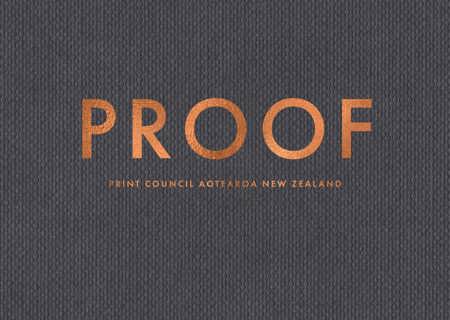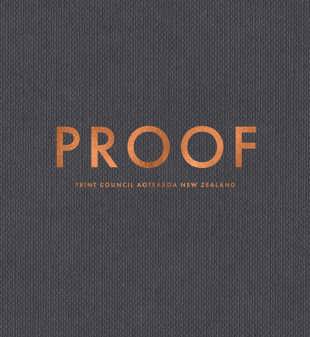Q1: What prompted Print Council Aotearoa New Zealand (PCANZ) to do this book now?
The idea of a publication about PCANZ had been discussed for a number of years. With the 20th anniversary of the foundation of Print Council approaching, it was decided the time was right to produce a book that outlined the important impact PCANZ has had on New Zealand printmaking, as well as an opportunity to celebrate its members. Printmaking is often an overlooked art form in New Zealand — there has not been a comprehensive publication featuring New Zealand printmaking and printmakers for many years. PCANZ saw Proof as another opportunity to create public awareness that printmaking in New Zealand is an active, vibrant, and rapidly growing part of the New Zealand art scene.
Q2: What defines printmaking as an art form?
The days of being able to give a definitive explanation of what printmaking is have gone. Particular fields of printmaking can still be described by a specific technique e.g. mezzotint, etching or woodcut, however, the field has expanded hugely in the past decades, especially with the impact of digital media. While printmakers have always embraced new technologies, they recognise that technique alone cannot describe content and argue for their work to be considered alongside its visual art counterparts. This does not mean a loss of tradition, but it has impacted on some conventions such as the ‘edition’. More and more artists are making hybrid prints — prints that call upon a range of materials and tools in order to explore contemporary ideas.
Q3: What do you want people to get out of reading the book?
Printmaking is a visual and frequently tactile art form, so it was important that the book was beautifully presented, a pleasure to handle, a book that enticed the reader into the world of printmaking. Proof is all we envisaged it to be. It is a wonderful, must-have resource for the individual printmaker, schools, tertiary institutions and libraries and features an extensive range of printmaking techniques.
Q4: How did you decide what works to feature?
As we wanted the book to be truly representitve of PCANZ printmakers, all those who were current members as of the year 2020 were invited to submit three images, one of which was selected for the book. During the selection process there was some consideration given to ensuring a range of techniques and approaches were shown, from the traditional to more contemporary, digital and three-dimensional work.
Q5: How are they ordered in the book?
The works are divided into three sections: Honorary members, which features selected artists who have been involved in PCANZ and made a major contribution to printmaking in Aotearoa; Life members, acknowledging those who have made exceptional past and current contributions to Print Council; and Participating members — current members of PCANZ.
Q6: PCANZ seems to be a close-knit and very supportive community. Why do you think this is so?
From its very inception, the philosophy of Print Council has been one of inclusiveness and support. It welcomes anyone who is interested in printmaking and endeavours to provide workshops and exhibition opportunities for all its members, wherever they are in their printmaking journey. As a member-run organisation it encourages, values and indeed depends on support from its members at a regional and national level. There has always been a willingness among printmakers to share ideas, new techniques and processes. Some of these require the use of expensive equipment that is not always readily available in the home studio (e.g. etching, lithography presses) so it is not unusual for printmakers to work in communal studio spaces which in turn fosters friendships and support.
Q7: Where do you see new technologies taking printmaking in the future?
The printed image has long historical, political and social associations where it has been able to change behaviour, inform many and agitate through visual persuasion. Printmakers have always embraced new technologies and if Albrecht Dürer (the German Renaissance printmaker) returned today to make prints, I am sure he would have used whatever technologies were available to widely disseminate his images. The invention of photography and screen-printing had an enormous impact on the art world, especially in the 1960s, and many significant artists have worked with commercial printing to both lift standards and to feature strongly in their studio production. New technologies will continue to be explored by artists, but for printmakers they are simply another tool to use if useful and appropriate for the ideas being generated.
Q8: With over 150 artists featured in the book there must have been some challenges in working with such a large group.
There was huge enthusiasm and support for the publication from PCANZ members and therefore a corresponding eagerness to participate. Once the publication team was established, made up of Kathy Boyle, Di Harries and Heather Partel, an initial administrative framework was drawn up to correspond with members, make decisions and meet deadlines. The team’s individual skills were key to the process running smoothly.
Q9: Was there extra pressure in producing a book for printmakers?
As a group of artists, it was important the publication showcase members’ work in a way they would be proud of. We want every member to open the book at their page and feel proud. With such a wide range of printmaking methods and experience the format of the book needed to honour every work individually as well as collectively. We think we have achieved that. It was important to reproduce images accurately and as close to the original colours and textures as possible.
Q10: Do you feel PCANZ is in good heart as it moves into its next 20 years?
When Print Council was established in Whanganui over two decades ago, the goal was to support printmakers within that central region of New Zealand. Those who started it did not envisage the lively, active, nationwide organisation it has become. PCANZ now supports its members in a variety of ways, with a full programme of events and opportunities every year. Its members are to be found in almost every region of New Zealand and many have excelled at a national and international level, both exhibiting and winning awards. Print Council membership continues to grow and strengthen across Aotearoa, with the membership currently the highest it has ever been. We feel very optimistic about the future.


